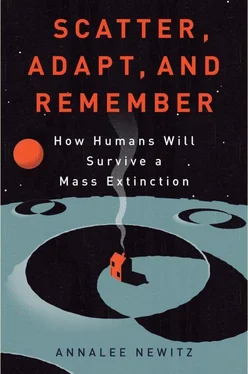Fossil remains in Europe suggest that about 500,000 to 600,000 years ago, some of H. ergaster ’s progeny, on emerging from Africa, decided to go left instead of right, wandering into the western and central parts of the Eurasian continent. These Europeans evolved into H. neanderthalensis . They often set up homes in generously sized cave systems, and there’s evidence that some groups lived for dozens of generations in the same caves, scattered throughout Italy, Spain, England, Russia, and Slovenia, among other countries. Neanderthals evolved a thicker brow and more barrel-chested body to cope with the colder climate. We’ll talk more about them in the next chapter.
Back in Africa, H. ergaster was busy, too, establishing home bases all over the coasts of the continent, reaching from southern Africa all the way up to regions that are today Algeria and Morocco. By 200,000 years ago, H. ergaster ’s skeletal shape was indistinguishable from that of modern humans. A species we would recognize as H. sapiens had emerged. And that’s when human beings made their next evolutionary leap—one that perfectly complemented our ability to walk upright into new domains.
How We Evolved to Tell Stories
“When Homo sapiens came along there was something totally radical about it,” Tattersall enthused. “For a hundred thousand years, Homo sapiens behaved in basically the same ways its ancestors had. But suddenly something happened that started a different pattern.” Put simply, humans started to use the giant brains they’d evolved to fit inside their gradually enlarging craniums. What changed? Tattersall said there are no easy answers, but evolution often works in jumps and starts like that. For example, birds evolved feathers millions of years before they started flying, and animals had limbs long before they started walking. “We had a big brain with symbolic potential before we used it for symbolic thought,” he concluded. In what anthropologists call a cultural explosion over the past 100,000 years, humans developed complex symbolic communication, from language and art to fashion and complex tools. Instead of looking at the world as a place to avoid danger and score food, humans disassembled it into mental symbols that allowed us to imagine new worlds, or new versions of the world we lived in.
Humans’ new facility with symbols allowed us to learn about the world around us from other humans rather than starting from scratch with direct observations each time we went to a new place. Like walking, symbolic thought is an adaptation that leads to more adaptations. Modern humans could venture into new territory, discover its resources and perils, then tell other bands of humans about it. They might even pass along designs for tools that helped us gain access to foods specific to a certain area, like crushers for nuts or scoops for tubers. Aided by our new capacity for imagination, those bands of humans could familiarize themselves with alien regions before ever visiting them. For the first time in history, people could figure out how to adapt to a place before arriving there—just by hearing stories from their comrades. Symbolic thought is what allowed us to thrive in environments far from warm, coastal Africa, where we began. It was the perfect evolutionary development for a species whose body propelled us easily into new places. Indeed, one might argue that the farther we wandered, the more we evolved our skills as storytellers.
Let’s go back, for a moment, to that first radiation out of Africa, nearly 2 million years ago when H. ergaster, with her small but effective tool kit, crossed into the Sinai Peninsula. At roughly the same time, we find evidence of humanity’s first genetic bottleneck. And yet, as Tattersall and many others have pointed out, there is no evidence of a giant disaster thinning the population, leaving the survivors to flee across the Middle East and Asia. The bottleneck is clearly a sign of a population crash, but what caused it? As I said earlier, the effective population size for H. sapiens is estimated at roughly 10,000 individuals; but the University of Utah geneticist Chad Huff recently argued that soon after H. ergaster left, our effective population size was about 18,500. It’s likely this bottleneck is actually a record of human groups growing smaller as they thinned out across the Eurasian continent, meeting adversity every step of the way. At the same time, according to anthropologist John Hawks, the bottleneck is a mark of evolutionary changes that could only happen to a population that was always on the move.
It started with that first trek out of Africa, which split humanity into several groups. As Hawks explained in a paper he published with colleagues in 2000, one cause for a genetic bottleneck can be speciation, or the process of one species splitting into two or more genetically distinct groups. We’ve already touched on how H. ergaster evolved into at least three sibling groups, but that’s a dramatic oversimplification. For example, H. ergaster likely evolved into a group called Homo heidelbergensis in Africa, which then speciated into H. sapiens and another group that speciated into Neanderthals and their close relatives the Denisovans later on. There are many complexities in the lineage of H. erectus, too, especially once the group reached Asia. Evolution is a messy process, with many byways and dead ends. By the time H. ergaster reached the Sinai, the group would have undergone at least one speciation event—the one that led to early H. erectus . That means only a subset of H. ergaster genes survived in H. erectus, and a subset of its genes survived in the H. ergaster groups who stayed behind. If these groups remained small, and there’s ample reason to believe that they did, you now have two isolated gene pools that are less diverse than the original one. That’s how speciation creates a genetic bottleneck.
But even without speciation events, humans’ habit of walking all over the place would have caused a bottleneck. The very act of wandering far from home, into many dangers, can shrink both the population and the gene pool over the course of generations. Population geneticists call this process the founder effect. To see how the founder effect works, let’s follow a band of H. erectus passing through lands edging the Mediterranean Sea and finding its way into India. Remember, this isn’t one long trek. Maybe the coast of today’s state of Gujarat appeals to a few members of H. erectus, and so a band decides to settle down for a while in that region. This settlement is called a founder group, and it has less diversity than the group it came from simply because it has fewer members. In the next generation, a new group splits off from the Gujaratis and heads south along the coast. Generally we assume that each time a group left for untouched lands, it left a group behind. So each new group becomes a founder population in its own right, and has less genetic diversity than the group back in Gujarat—even if you factor in some intermarriage between different founder groups. Multiple founder events in a row would have had the odd effect of increasing humanity’s population while decreasing human genetic diversity. Now, consider the fact that our H. erectus explorers in India are a microcosm of the way all humans spread across the Earth. After hundreds of generations of wandering, humans managed to increase their populations gradually while retaining the low diversity caused by genetic bottlenecks.
Back in Africa, early humans were also speciating and wandering, forming new bands, each of whose genetic diversity was lower than the last. But when a small band of hominins called H. sapiens evolved, about 200,000 years ago, something strange happened. Tattersall believes that humans underwent some kind of genetic change that spurred a cultural shift. Suddenly, between 100,000 and 50,000 years ago, the fossil record is full of sculpture, shell jewelry, complex tools made from multiple kinds of material, ochre-and-carbon cave paintings, and elaborate burial sites. Possibly, as Randall White, an anthropologist at New York University, suggests in his book Prehistoric Art , humans were using jewelry and clothing to proclaim allegiance with particular groups. H. sapiens wasn’t just interacting with the world. They were using symbols to mediate their relationship with it. But why the sudden shift from a hominin with the capacity for cultural expression to a hominin who actively created culture?
Читать дальше






![Аннали Ньюиц - Автономность [litres]](/books/424681/annali-nyuic-avtonomnost-litres-thumb.webp)





